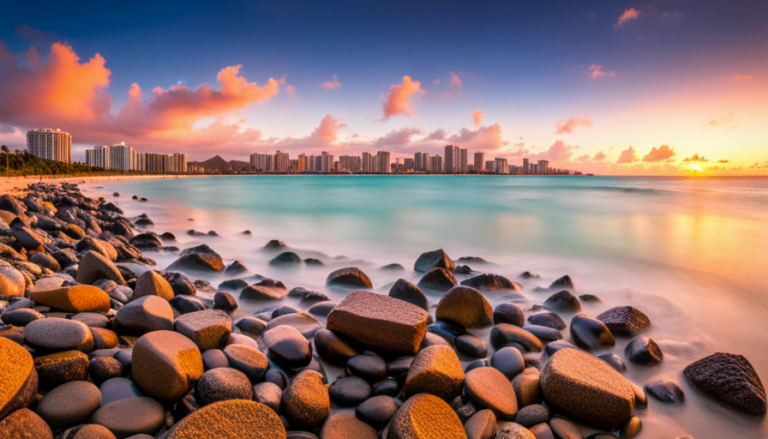“Sustainable Paradise: Oahu’s Eco-Warriors Paving the Way 🌺”
Welcome to the bustling island of Oahu, where sustainability is a top priority. As a visitor or resident, you play an important role in ensuring the long-term health and prosperity of this beautiful place.
From reducing carbon emissions to preserving natural resources, the efforts made towards sustainability on Oahu have far-reaching impacts that benefit both the environment and the economy.
Oahu is a small island with a big impact. Its population of nearly one million people and millions of visitors each year can put a strain on the island’s resources and infrastructure. However, through a concerted effort to promote sustainability, Oahu is working towards a future that is both prosperous and environmentally responsible.
In this article, we will explore the importance of sustainability on Oahu, the actions being taken to reduce the island’s carbon footprint, and the collaborative efforts between local communities and businesses to achieve a sustainable future.
Key Takeaways
- Oahu prioritizes sustainability for long-term health and prosperity, with sustainable practices benefiting both the environment and economy.
- Sustainable initiatives include investing in renewable energy, promoting sustainable transportation, and encouraging eco-friendly practices, while challenges include initial cost and resistance from stakeholders.
- Community involvement, collaboration with local organizations and leaders, and education programs are crucial to promoting sustainability and tailoring solutions to unique community needs and perspectives.
- Oahu’s sustainability plan, Aloha+ Challenge, aims for 100% renewable energy, zero waste, and sustainable food production by 2045, along with initiatives to protect and restore watersheds and promote sustainable tourism.
Understanding the Importance of Sustainability in Oahu
If you’re curious about why sustainability is so crucial to Oahu, you’re in the right place! The benefits of sustainability practices are numerous and far-reaching.
Sustainable solutions not only reduce the negative impact on the environment but also improve the quality of life for residents. By implementing sustainable practices, Oahu can reduce its dependence on imported goods, preserve natural resources, and improve local economies through the creation of new jobs.
However, implementing sustainable solutions also presents challenges. One of the biggest hurdles is the initial cost of adopting new technologies and practices. Additionally, there may be resistance from stakeholders who are comfortable with the status quo.
Nevertheless, the importance of sustainability cannot be overstated. Its benefits are crucial to the future of Oahu, and the island must continue to prioritize sustainable practices in order to ensure a brighter and more sustainable future.
With that in mind, let’s move on to the next section about reducing the island’s carbon footprint.
Reducing the Island’s Carbon Footprint
To reduce Oahu’s carbon footprint, you can start by investing in renewable energy sources. This includes solar, wind, and hydro power, which are becoming more cost-effective and accessible.
Another way is to promote sustainable transportation options such as biking, walking, and public transport, which can significantly reduce emissions from cars.
Finally, encouraging eco-friendly practices such as composting, reducing waste, and using sustainable products can also contribute to a cleaner and greener future for the island.
Investing in Renewable Energy Sources
You can help Oahu achieve sustainability by investing in renewable energy sources, like solar or wind power. Hawaii is a leader in renewable energy, with a goal to reach 100% renewable energy by 2045. There are various options for investing in renewable energy on the island, including installing solar panels on your home or business, investing in community solar projects, or purchasing renewable energy credits.
Investing in renewable energy not only benefits the environment, but it can also provide financial incentives. Hawaii offers tax credits and rebates for those who install solar panels, as well as net metering, which allows you to sell excess energy back to the grid. Additionally, community solar projects allow individuals to invest in a larger renewable energy system and receive credits on their electricity bills. By investing in renewable energy, you can not only reduce your carbon footprint but also save money on your energy bills.
Promoting sustainable transportation options is another way to contribute to Oahu’s sustainability efforts.
Promoting Sustainable Transportation Options
One way to get around the island while helping the environment is by taking advantage of the public transportation system or riding a bike. The City and County of Honolulu offers a bus system that’s accessible and affordable, with routes that cover most areas of the island.
In addition to reducing carbon emissions, using public transportation also helps decrease traffic congestion and improves air quality. For those who prefer a more active mode of transportation, biking infrastructure has been improving on Oahu in recent years. The city has been adding bike lanes and paths to make biking safer and more convenient.
Biking not only promotes sustainability but also provides health benefits for individuals who choose to use it as a mode of transportation. By taking advantage of these eco-friendly options, you can reduce your carbon footprint while also improving your health and well-being.
Moving forward, encouraging eco-friendly practices can have a significant impact on the sustainability of Oahu.
Encouraging Eco-Friendly Practices
Hey, if you’re looking to make a positive impact on the environment, why not try incorporating some eco-friendly practices into your daily routine? There are many simple changes you can make that can have a big impact. Here are some ideas:
- Use eco-friendly cleaning products that are free of harsh chemicals and pollutants.
- Invest in reusable shopping bags and water bottles to reduce plastic waste.
- Participate in community clean-up events to help keep our streets and beaches clean.
- Choose locally-sourced and organic produce to support sustainable agriculture.
- Reduce your energy consumption by turning off lights and electronics when not in use.
By incorporating these eco-friendly practices into your daily routine, you can help reduce your carbon footprint and contribute to a more sustainable Oahu.
Community involvement is also key to promoting sustainability, so consider joining local groups and organizations that work towards a more eco-friendly future.
As we work towards a more sustainable future, it’s important to also focus on preserving natural resources for future generations. One way to do this is by reducing our reliance on non-renewable resources and investing in renewable energy sources.
Let’s explore some ways we can do this together.
Preserving Natural Resources for Future Generations
Imagine living in a world where the natural resources of Oahu are no longer available for future generations to enjoy. This could be a reality if we don’t take steps to preserve the island’s natural resources.
Education programs and government policies play an essential role in preserving the natural resources of Oahu. Education programs can help raise awareness about the importance of preserving natural resources and the impact of human activities on the environment. By educating the public, we can encourage more people to make sustainable choices and reduce their carbon footprint.
On the other hand, government policies can provide incentives for businesses and individuals to adopt eco-friendly practices. For example, the government could offer tax breaks or rebates for those who invest in renewable energy sources or reduce their energy consumption. By working together, we can ensure that the natural resources of Oahu are preserved for future generations to enjoy.
Preserving natural resources is just one step towards promoting economic growth and quality of life. By preserving the natural resources of Oahu, we can also attract more tourists and businesses to the island. This will create new job opportunities and increase the standard of living for the people of Oahu.
Let’s work together to ensure that we leave a healthy and vibrant Oahu for future generations to enjoy.
Promoting Economic Growth and Quality of Life
As the island of Oahu continues to grow and develop, it’s important to consider the impact on both the economy and quality of life for its residents.
With a focus on sustainability, it’s possible to promote economic growth and improve the well-being of the community for years to come.
Community involvement is key to creating innovative solutions that benefit all parties involved. By encouraging businesses and residents to take an active role in sustainability efforts, we can create a more resilient economy that’s less dependent on finite resources. This can include initiatives such as renewable energy projects, waste reduction programs, and sustainable transportation options.
Additionally, promoting sustainable practices can lead to cost savings for businesses and individuals, improving the overall economic health of the island.
When collaborating with local communities, it’s important to consider their unique needs and perspectives. By listening to their concerns and ideas, we can create solutions that are tailored to their specific challenges and opportunities.
This can include partnering with local organizations and leaders to develop sustainable initiatives that address issues such as food security, affordable housing, and access to green spaces. By working together, we can create a more vibrant and sustainable future for all residents of Oahu.
Collaborating with Local Communities
You can increase community involvement and create tailored solutions by collaborating with local organizations and leaders, ensuring that everyone’s unique needs and perspectives are considered. Community partnerships are essential for sustainability efforts in Oahu.
By working together, local engagement can be increased, and initiatives can be more effective in addressing the challenges faced by the island. Local engagement can take different forms, such as community meetings, workshops, or surveys. These activities can help gather information and feedback from residents, which can help shape sustainability plans and projects.
Additionally, local organizations and leaders can play a crucial role in advocating for sustainability and promoting behavior change among community members. Through collaboration, everyone can contribute to building a more sustainable future for Oahu.
As sustainability efforts continue to progress, it’s essential to keep a long-term vision for Oahu’s future. By building strong community partnerships and engaging with local organizations and leaders, sustainable initiatives can be more effective and have a lasting impact.
The next section will explore some of the future challenges and opportunities for sustainability in Oahu.
The Future of Sustainability in Oahu
As you continue to explore sustainability efforts in Oahu, it’s important to consider the goals and initiatives for the future.
Oahu’s sustainability plan, called Aloha+ Challenge, aims to achieve 100% renewable energy, zero waste, and sustainable food production by 2045.
To achieve these goals, initiatives like the Green Energy Money $aver program and the Plastic Free Hawaii campaign are already underway.
As a visitor, you have opportunities to support these efforts by participating in beach cleanups, using public transportation or electric car rentals, and choosing eco-friendly accommodations.
Goals and Initiatives for the Future
Looking ahead, Oahu has set ambitious goals and implemented various initiatives to promote sustainability and protect the island’s natural resources. Here are some of the major goals and initiatives that the island has put in place:
- By 2030, Oahu aims to achieve 100% renewable energy use for electricity generation. This goal is supported by various initiatives, such as the installation of solar panels on public facilities and the development of offshore wind farms.
- Oahu also aims to divert 70% of its solid waste from landfills by 2020. To achieve this goal, the island has implemented a comprehensive recycling program and is promoting waste reduction through education programs and community involvement.
- Another key initiative is the protection and restoration of Oahu’s watersheds. The island is working to preserve its forests, which are crucial for maintaining the health of its watersheds and preventing erosion and sedimentation in streams and coastal areas.
- Finally, Oahu is committed to promoting sustainable tourism and reducing the impact of visitors on the island’s natural resources. This includes initiatives such as promoting eco-tourism, encouraging visitors to use public transportation, and reducing the use of single-use plastics in hotels and restaurants.
As you can see, Oahu is taking sustainability seriously and has set ambitious goals to protect its environment for future generations. The island also recognizes the important role that visitors can play in supporting sustainability efforts.
In the next section, we’ll explore some opportunities for visitors to get involved and help protect Oahu’s natural resources.
Opportunities for Visitors to Support Sustainability Efforts
Visitors to Oahu can actively contribute to preserving the island’s natural resources by participating in sustainable tourism activities. Eco tourism opportunities abound in Oahu, from exploring the island’s lush forests and marine sanctuaries to supporting local agriculture and renewable energy initiatives. By choosing to participate in activities that have minimal impact on the environment and promote conservation efforts, visitors can help ensure that Oahu remains a sustainable destination for generations to come.
In addition, visitors can also support sustainability efforts by choosing to purchase sustainable souvenirs. The table below provides some examples of souvenirs that are eco-friendly and support local businesses and conservation efforts. By making informed choices about the products they purchase, visitors can help reduce the environmental impact of their trip and support the sustainability of Oahu’s economy and natural resources.
| Sustainable Souvenir | Benefits |
|---|---|
| Locally-made crafts | Supports local artisans and reduces carbon footprint |
| Reusable water bottles | Reduces single-use plastic waste |
| Reef-safe sunscreen | Protects marine ecosystems from harmful chemicals |
| Organic or fair-trade products | Supports sustainable agriculture and fair labor practices |
Frequently Asked Questions
What specific actions is the government taking to incentivize sustainable practices among local businesses and residents?
Get green with government incentives and community engagement. Local businesses and residents are encouraged to adopt sustainable practices through tax breaks, grants, and workshops. Join the movement towards a more eco-friendly future.
How are Oahu’s tourism industry and sustainability efforts being balanced to promote both economic growth and environmental preservation?
To balance tourism impact and sustainability, Oahu has implemented green infrastructure and eco-tourism initiatives, such as beach cleanups, bike-sharing programs, and LEED-certified hotels. These efforts promote economic growth while preserving the island’s natural resources.
Are there any notable success stories of sustainable initiatives in Oahu that can serve as models for other communities?
You won’t believe the impressive community engagement and corporate responsibility demonstrated by Oahu’s sustainable initiatives! There’s the Kahuku Wind Farm, which powers 7,700 homes, and the H-Power plant, which converts waste into energy.
What challenges are unique to Oahu’s sustainability efforts compared to other regions, and how are they being addressed?
To address unique challenges in sustainability, Circular economy solutions are being applied in many regions. Community based sustainability initiatives are gaining traction in engaging locals. Hawaii’s geography increases reliance on imports, creating challenges for waste reduction and energy independence.
How is Oahu working to reduce its reliance on fossil fuels and transition to renewable energy sources?
Reducing reliance on fossil fuels and transitioning to renewable energy sources is a top priority for Oahu. Innovative projects such as a 20 MW solar farm and community engagement in sustainability initiatives have helped the island reach its goal of 100% renewable energy by 2045.







